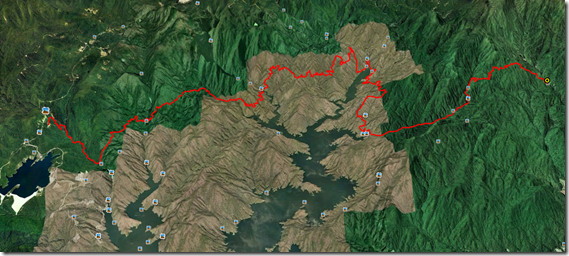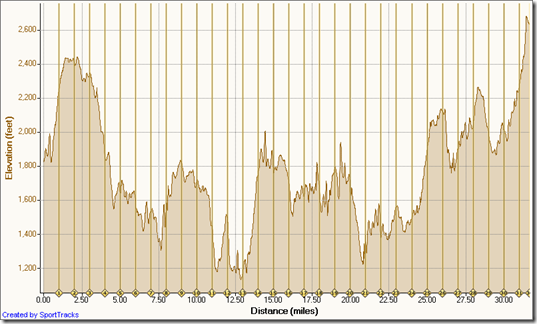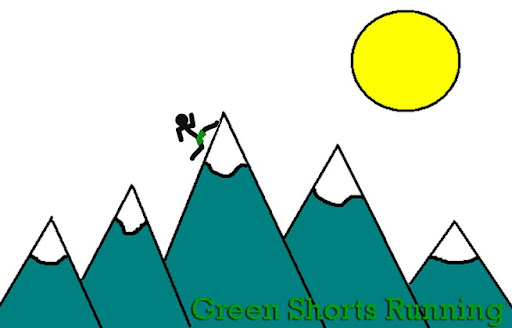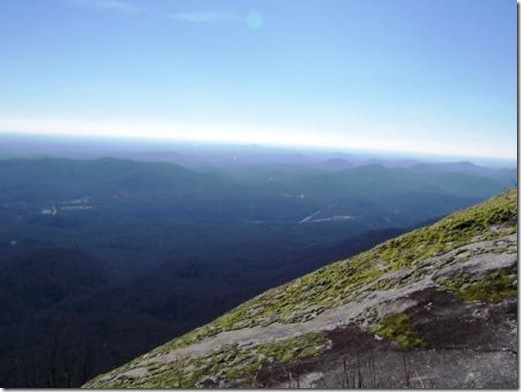Entrants in the Laurel Valley 35 mile race can’t say they weren’t warned about what to expect. The race site is on Claude Sinclair’s “Runner from Hell” homepage, complete with burning flames graphics and the words, “Some Runners are Tough, Some Runners are Insane, Some Runners are Both.” The race qualification requires a 50 mile race completion, and the waiver clearly states that this will likely be the toughest run you will ever do and may cost you your life. It also strongly suggests taking a light and blanket, because you very well might end up sleeping on the course. And the last pre-race email includes these words:
If you are allergic to Yellow Jacket stings then please don’t even attempt this run. You will get stung and probably more than once. That is just part of the pain that the course has to offer.
Despite this, the race sells out every year with a who’s-who of the area's hardcore ultra runners- the CR holders are Clark Zealand and Annette Bednosky.
It’s very apparent that this is a unique race. First of all, no one agrees how long it is- in fact, this was a 15 minute point of discussion at the finish yesterday. It’s generally accepted the race is somewhere between 30-40 miles. Ish. All we know is that it follows the Foothills Trail (FHT) from Rocky Bottom, SC to Whitewater Falls, NC. Garmin’s don’t due well due to lush foliage, switchbacks, and the steps (more on those later). Ground track puts it at 35.7 miles, so that is the “official” distance on the finisher plaques. Will Brown tells how Claude attempted to have the sweeps (the safety runners who bring up the rear) wheel the course one year. They very carefully push the measuring wheel the entire way, gingerly navigating rocks, trees, and the steps (more on those later) for 12 hours. They finally arrive near the finish, ascending the last 500 steps, as Claude waits in anticipation. With just a few stairs to go, the counter on the wheel suddenly falls off and is lost, along with any hopes of knowing the true length. I think the course just doesn’t want us to know.
Aside from the unknown length, it’s generally obvious why this race is so difficult. Primarily, it is run across the Foothills trail, traversing the most technical terrain of South Carolina. In the middle of August. With no aid stations. None. And there are no signs of civilization, other than the bridges and steps (more on those later) that were surely built by some primitive civilization, probably aided by aliens. Other than the start and finish, you are never closer than 5 miles to a road. Once you start, you cannot DNF- you have to finish or turn around and go back to the start. You are very isolated- you are as likely to see bear and wild boar as people. But this race reminds me of the Grand Mesa 50, in that there are just a bunch of small, almost intangible things that add up. The heat. The humidity. The endless false summits. Running 4 hours without seeing a single person. Boulder scrambling. Dramatic drop offs. The first course marking is within a mile of the finish line. And, the smallest thing, the stairs (more on those right now).
The Stairs
LV35 starts at the base of some steep stairs. And I mean that literally. Right at the base- no 100 meter run first to work out position. Claude shoots his shotgun to start the race (again, literally, except this year cause his shells were wet), and you immediately start stepping. Although, being the south, everyone is polite and lets others go first, so we all stood there for 5 seconds, trying to figure out who would go first. Then, over the next 30-40 miles, you will climb and descend somewhere around 5000 steps. That’s a whole stinking lot of stairs. Up and down mountains. You don’t realize the wide variety of steps until you run LV. Some steps are very even with nice handrails (left photo is the starting line).
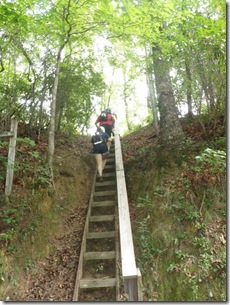
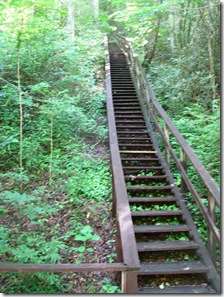
Some are a bit steeper and more challenging.
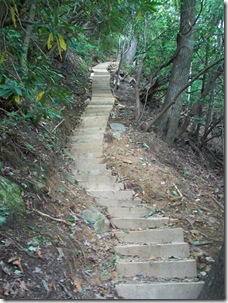
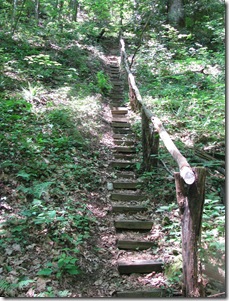
And some are so dramatic that it almost seems as the Creator himself must have put them in, for surely no man could have been crazy enough to build steps up that steep of a mountain…
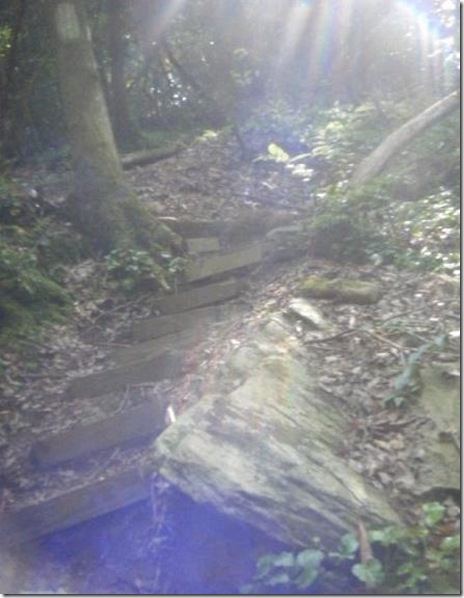
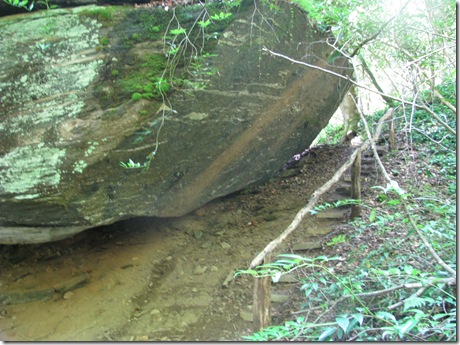
Photos courtesy of Jason Sullivan, Barry Burns, Psyche Wimberly, and Google Images.
I have a spreadsheet I use to predict split times at races based on distances, elevation change, temperature, etc. However, I found my spreadsheet is wholly inadequate for LV. Following the laws of trail running and physics, it assumes that running downhill is faster and easier than running uphill. Indeed, this is generally true. However, when the downhill consists of carefully picking your way down uneven, huge steps on 45 deg slope, the law of Laurel Valley trumps the laws of physics, rendering downhill the slowest direction of all. Especially when the steps are wooden, moss-covered, and wet.
The Race
I continued my pre-race tradition of restlessness Friday night, only sleeping about 3 hours. I left at 4:20 am for the 70 min drive, arriving to find the parking lot bustling with the activity of about 40 racers (the 5 am starters were already gone). After the usual preparations, we were ready to go. The only item of note was that 5-time winner Brian Kistner would not be running. Right at the 6 am signal, 2010 winner John Dove was the first one up the stairs, followed by 15-time finisher and local legend Byron Backer, with me right behind. The temperatures were mid-60’s, 10 degrees cooler than the past month, but the 100% humidity had my shirt soaked within the first mile. I quickly removed it and carried it the rest of the way. Byron and I talked for the first 45 minutes, up and over the first climb and descent as the sun slowly rose over the mountains.
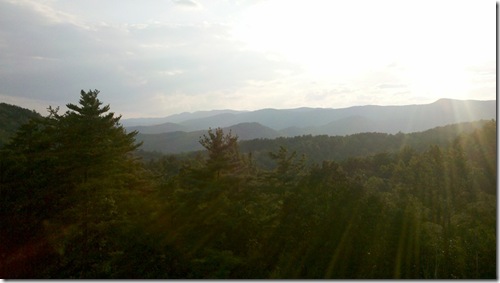
We hit a flat stretch, and I passed him and pulled away just as we caught the 5 am sweeps. Miles 4-7 are generally fast as the trail follows a river past the beautiful Virginia Hawkins Falls and Laurel Fork Falls. Reaching Lake Jocassee, the trail then climbs for several miles and passes into North Carolina. I passed more 5 am starters, then John Dove. Shortly after the top, 10 miles and 1:45 into the race, I passed the front 5 am starter, who informed me I was now in the lead. Even if he hadn’t told me, I would have immediately figured this out due to the pleasure that only the lead runner at LV35 can experience:
Spider Webs
The LV spiders are some of the most industrious on earth, capable of building webs that can span any distance. 1 foot gap between 2 bushes and a singletrack trail? No problem. 3 foot span between handrails on 3 dozen bridges? You bet. 4 foot gap between a tree and a rock with a doubletrack trail in between? Can do. 8 foot gap between 2 trees and a fireroad? We’re on it. Fortunately, they are also very fertile, taking quite seriously their duty to multiply and fill the earth, or at least the FHT portion of it. Finally, in order to catch the huge South Carolina insects and even the stray bird or mammal, they have perfected the industrial strength web. NASA consulted with the spiders to ensure maximum adhesion and tensile strength. But the spiders want to test their strength, and so recruited Claude to put on a race for the sole purpose of having a hapless runner test the strength of hundreds of the webs, at ankle, leg, hair, chest, and (best of all) face-height. I would estimate that I encountered at least two webs each minute (this is likely an underestimate- there were sometimes 4 webs in a 20 foot span). Multiply this by 4.5 hours in the lead and… well, you get the picture. When I was lucky enough to see the sun glinting off them or a HUGE spider in the middle, I would often stop, find a stick, and swipe until the path was clear. I probably did this at least 50 times. But when I didn’t see them, or by the end when I was too tired to care, I just plowed right through. The best is when they hit right in the open mouth- by the end, you just swallow the web, hoping the spider is there for extra protein. Who needs gu?!?
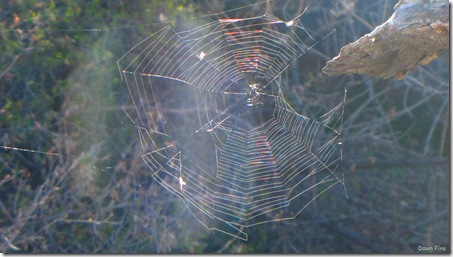
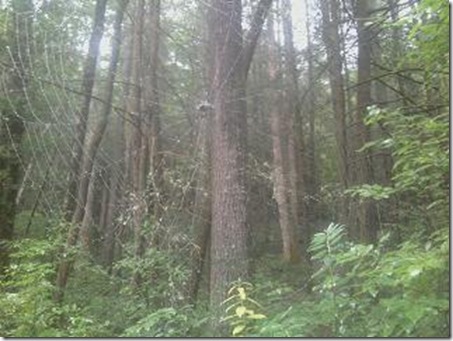
(The bottom photo is an actual FHT spider web)
The Race (cont.)
The course proceeded up and down the steepest climb of the race just after Rock Creek (300 ft down the lovely stairs in about .2 mile), the crosses the huge Toxaway suspension bridge above the lake before climbing back up the mountains. The air was getting warmer, hitting mid-80’s, and I had to slow on the uphill to not overheat. After several miles of long ups and downs, I reached the much anticipated BAS at mile 17.7 and 3:13.
BAS
BAS, also known as the Barry Aid Station, was how I dealt with the lack of aid on the  course. Rather than risk sickness by drinking straight from the streams, and unwilling to carry 180 oz of water or stop to filter, Barry generously volunteered to backpack 7 miles through Gorges State Park while carrying 2 gallons of water, camp overnight (in the rain with only a hammock for protection), then hike back out. The sole purpose: to refill my water and gu’s and offer a change of shoes and clothes. I arrived at the BAS to the barking of the two dogs, but Barry was no where to be found. He quickly came sprinting from the other direction, jumping into action. In less than 150 seconds, he had refilled my 90 oz of water, reloaded my gu’s and S-caps, and sent me on my way with encouraging words. By my estimate, Barry spent 25 hours (including 3.5 hiking) just for those 2.5 minutes of helping me. Friendship in its truest form- thanks, Barry. He even managed to snap this action photo of me pulling away.
course. Rather than risk sickness by drinking straight from the streams, and unwilling to carry 180 oz of water or stop to filter, Barry generously volunteered to backpack 7 miles through Gorges State Park while carrying 2 gallons of water, camp overnight (in the rain with only a hammock for protection), then hike back out. The sole purpose: to refill my water and gu’s and offer a change of shoes and clothes. I arrived at the BAS to the barking of the two dogs, but Barry was no where to be found. He quickly came sprinting from the other direction, jumping into action. In less than 150 seconds, he had refilled my 90 oz of water, reloaded my gu’s and S-caps, and sent me on my way with encouraging words. By my estimate, Barry spent 25 hours (including 3.5 hiking) just for those 2.5 minutes of helping me. Friendship in its truest form- thanks, Barry. He even managed to snap this action photo of me pulling away.
The Push
After the BAS, I started doing the math in my head and realized that my 6 hr goal would be increasingly difficult. I pushed hard for the next 2 hours. Very hard. I had no idea where the next runner was behind me, though I doubted anyone would catch me. But I could not have run any harder even with someone right on my heels. This was a race, and I was determined to race it. I kept the 6 hour goal in the front of my mind, urging myself to go faster and faster. I ran up long climbs and bombed descents. My legs ached from the 90 miles I had already run that week, but they churned onwards. I crossed Horsepasture River at 3:48, estimating the last 11 miles would take about 130 minutes. The trail along Bearcamp Creek provided a relatively flat, if particularly spider-infested, break from the many climbs. It is one of my favorite sections of the trail.
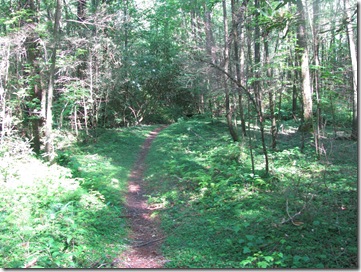

By the time I reached Thompson River at mile 26.6 at 5:02, I had accepted that my sub-6 goal had slipped away. Disappointed, I pressed up and down the trail to Bad Creek access point, just trying to hang on (and also trying to outrun my own overpowering stench). The relatively flat trail followed the Whitewater River upstream for 1.5 miles across another stretch of beautiful, soft trails. Finally, the trail crosses some boulders and a bridge before the final 600 ft climb to the waterfalls overlook (complete with several hundred more stairs, of course).
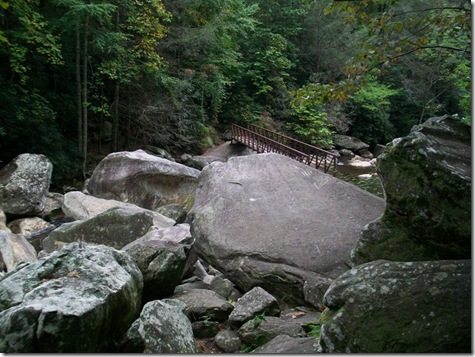
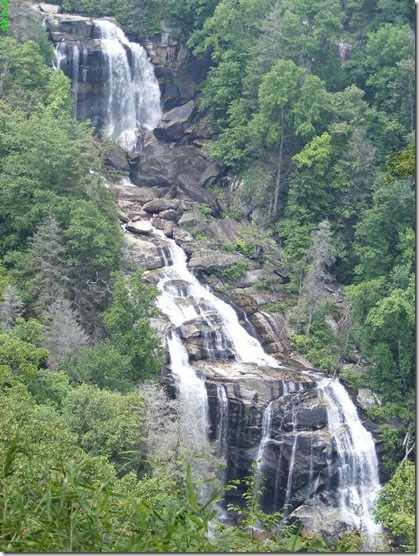
Tourists crowded the platforms and steps, with one even asking why I was sweating so much (I replied it was because I had been running for the past 6 hours). I reached the top and ran down the paved trail to the picnic shelter, where only Claude, his wife, and one volunteer, Stephen Morris, were waiting. Final stats were about 31-32 miles in 6:05:50 with about 7600 climb/6700 descent (or 10,300/9600 per SportTracks).
Other racers’ family members trickled in, with Barry showing up at 12:30 with a jug of my post-run favorite chocolate milk in-hand (again, thanks). We waited another 30 minutes, with Claude jokingly asking if I had removed the (non-existent) course markers or set booby traps that stopped all the following runners. I finally went to the bathroom to wash up a bit and change clothes. I returned to find that 6 runners had arrived in that 10 minute period (including 2 ladies), led by Byron in 7:17:09. After a bit of the usual post-race chat with the finishers, Barry drove me back to my car. Thunderclouds turned to a downpour on the way, which I’m sure added some adventure for the many racers still on the course. The 2+ hr drive saw me return home at 4:30 pm, 12 hours after leaving. I was relieved that Marci hadn’t gone into labor during that time, a real possibility since she’s in her final month (thanks for letting me go do another crazy run, babe). And when told of my win, McKinley excitedly said that I am “super-duper fast!” In an interesting fact, I have entered 4 trail runs this year, winning 3 of them and DNF-ing the other. I think that is my most wins ever in one year.
Overall, the Laurel Valley 35 mile ultra is a great run. Very challenging, but very rewarding. If you want lush vegetation, picturesque waterfalls, swinging bridges, wildlife, and self-supported solitude, with just a few stairs along the way, then come try it. And let’s face it- if you read this entire novel of a race report, then you’re obviously interested! I’ll probably do this race every year I am in SC, and maybe I’ll even taper one year to give myself a decent shot of breaking 6 hrs or even 5:30. But, Clark’s CR of 5:02 is out of reach- of all the trail races I’ve ever done, I would call that the most untouchable CR ever.
